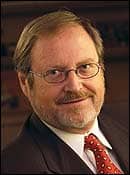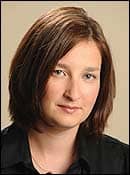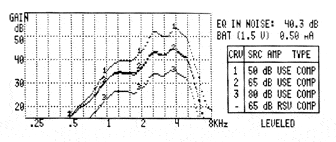
|
| Thomas Powers, PhD |
Executives in the hearing industry were pleasantly surprised in 2009, a year that began with massive banking woes and plummeting economic indicators. In business as in life, when you expect the worst but end up with pretty good, things don’t seem so bad.
While hearing aid manufacturers were used to double digit growth in years past, even the most upbeat sales managers tempered their optimism as 2009 staggered to the starting line. At Piscataway, NJ-based Siemens Hearing Instruments, Thomas Powers, PhD, says the industry had been relatively immune to previous economic downturns. This year, however, was far from business as usual. “Yes, we have been somewhat recession proof, but the economy has definitely had an impact this time around,” admits Powers, vice president, audiology and compliance at Siemens. “For probably the first three quarters of the recession, the overall market conditions definitely had an effect. But the past couple of quarters, we are starting to see things come back, slowly, but they are coming back.”
Part of the slowdown can be attributed to the senior market. Far more payment aids are available to pediatric patients, but customers 65 and up must, of course, pay out of pocket—a situation only made worse for seniors on fixed incomes experiencing shrinking stock portfolios. Faced with these daunting factors, the $3,000 to $4,000 price tag for hearing aids is a big deal. “In this type of climate, many times people do not go out and make these kinds of purchases, and certainly in the past year or so, they have probably deferred some of those purchases just to see what the overall economy was going to do,” says Powers. “We may have grown only in the low single digits this year, but on the upside it’s been a long time since we have seen negative growth.”
Worst-case scenarios failed to play out among hearing aid manufacturers this year, thanks largely to dispensing activity associated with the Department of Veterans Affairs (VA). As reported in Hearing Review, hearing aid unit sales increased almost 5% in the first half of 2009, compared to the same period last year. Take out those VA sales, however, and you wind up with anemic private sector growth of 1.7% (as reported by the Hearing Industries Association).

|
| Scott Witt |
Midwestern hearing aid maker Phonak also started with conservative estimates for the year, only to find that an expansion of manufacturing space was warranted to keep up with demand. “We are actually exceeding our expectations, especially given the poor economy,” says Scott Witt, director of engineering at Phonak, Warrenville, Ill. “We are quite pleased that we are continuing to experience growth, especially in the last 10 months. We just had a ribbon cutting for a 2,100-square-foot space at our US headquarters, which is devoted mostly to new product final assembly. We squeezed everyone in the office spaces to make more room for this.”
Witt anticipates that one of Phonak’s most formidable challenges in coming years will be finding space. The market for hearing products will only grow larger, and additional employees must have room to work. “Even in the down economy, we are continuing to hire in all parts of the business,” says Witt. “We are hiring people in the sales, marketing, and customer service groups—and definitely in the manufacturing area. What we have done well in the past couple of years [to warrant expansion] is to broaden our product portfolio, and focus on service excellence.”
Jerry Ruzicka, president of Starkey Laboratories Inc, Eden Prairie, Minn, points out that hearing aids are no longer strictly a cash-based business. With the banking crisis, particularly during the fourth quarter of last year, he says manufacturers started to see consumer credit being used a great deal in the sales of hearing aids.

|
| Peer Lauritsen |
Like many manufacturers, Ruzicka’s perspective on the year depended a great deal on expectations going in. “We went into the year with a lot of caution because of the recession and all the unknowns related to it,” says Ruzicka, whose company manufactures custom and traditional hearing aids. “We planned for growth, and overall we have been pleased with the year, because we reached the growth we were looking for. The difference we have seen in the past year is that the private sector has been fairly flat, but there has been lots of growth in the VA, and the VA is now the largest consumer of hearing aids in the United States. I believe they are seeing a lot of Vietnam veterans coming into the system, and more service-related hearing loss in general.”
Nabbing that non-VA private sector business, however, is an undeniably difficult proposition. Peer Lauritsen, president of Oticon Inc, Somerset, NJ, believes a good marketing campaign can help dispensers capture some of this market. “Our customers have stepped up and met the challenges, and used many of the programs we have put in place,” says Lauritsen. “TV campaigns, newspaper inserts, and direct mail campaigns have all been very effective—and all have helped our dispensers to excel in their practice.”
For manufacturers in the hearing protection business, all the savvy marketing in the world can’t help if noisy heavy machines are not humming full tilt. “We and all hearing protection manufacturers are affected by the number of people working what I like to call ‘ear hours,’” says Renee S. Bessette, marketing manager, Howard Leight/Sperian Hearing Protection LLC, Smithfield, RI. “How many people are wearing hearing protection during the workday, and how long are they wearing it? We have seen a reduction in staffing, especially in industry and manufacturing, and that has had an impact on all of our business.”

|
| Renee S. Bessette |
On the positive side, Bessette reports that a slew of innovative product offerings at Howard Leight/Sperian have kept sales relatively stable, and prepared the company well for the future. At the same time, people care about protecting their hearing more than ever.
Even with increased protection awareness, it is still a challenge to compensate for sluggish job creation. “If you think about just the automotive industry, they have had plants go dark,” laments Bessette, who also serves as director of public relations and marketing for the National Hearing Conservation Association. “Those are typically the kind of industries—and associated industries such as upholstery makers or car windows—that have also been affected by the recession.”
Diversifying product offerings is a successful tactic used by officials at Westone Laboratories, Colorado Springs, Colo. “Over the last few years, we diversified into several related markets—for example, music and military products,” says Lynn Kehler, president and CEO of Westone. “This, coupled with our market position, helped insulate Westone from much of the economic weakness in 2009. While we’ve experienced some moderation in parts of our business, we have exceeded our expectations overall.”

|
| Lynn Kehler |
While initially concerned about introducing high-end music products in a weak economy, Kehler has been pleasantly surprised by the strength in demand. “I think you’ll find that in a soft economy, consumers go out of their way to seek out excellent quality and value for their dollar,” says Kehler. “Relative to the hearing health care industry, there has been some industry softness in late 2008 and 2009. The industry market data suggest that the VA market has seen the strongest growth, and the commercial sector has been relatively flat in 2009.” While things are getting better for the hearing industry overall, Kehler cautions that full recovery will likely take time. “We are beginning to see indications that the worst of the recession is over,” remarks Kehler. “However, I believe that job creation will come slowly, which could impact consumer spending on hearing health care. We hope to see a gradual strengthening in our business in 2010, particularly in hearing health care, hearing protection, and music products. We also have several longer-term initiatives that revolve around making things simpler, faster, and easier for our customers to do business with us.” Whether it’s hearing aids or hearing protection, manufacturers across the board have also attempted to cope with difficult times with a stream of new products ready made for the digital age. These power-hungry new devices require increasingly sophisticated and environmentally friendly batteries, and companies such as Energizer Inc have responded to the demand.
Determined to get well ahead of federal legislation (set to go into effect June 2011) to get mercury out of hearing aid batteries, engineers at Energizer developed a mercury-free battery and rolled it out this year. “With this pending legislation, there was a race to the marketplace to produce a mercury-free product,” says Richard M. Freeman, national sales manager, microbatteries, for St Louis-based Energizer. “We rolled out first.”
Overall, Freeman says his company has so far exceeded expectations, reporting growth in the “high single digits” in 2009. Some of that growth can be attributed to juice-thirsty digital products, while the crucial nature of batteries accounts for the rest. “If you run out of battery power, it’s the last thing you are going to scrimp on,” says Freeman. “You are going to want to hear. Some people wear their hearing aid 24/7, while others turn it off at night—which can cut back on battery usage.”
Additional accessory products such as the Hearing Aid Sweat Band have carved out a niche by extending the life of hearing aids in dirty environments. “In a challenging economy, we find our business performs well as the costs to repair hearing aids or replace batteries—due to moisture problems and dirt and grime infiltration—become a burden on tightened budgets,” says Scott VanBuskirk, owner of VanB Enterprises, West Valley, NY. “Our product becomes a smart investment and can reduce user costs in the long term.”
HEARING ON THE HILL
Along with colleagues from Siemens, Thomas Powers made his way to Washington, DC, this year for the Hearing on the Hill lobbying push for the much-talked-about proposed $500 hearing aid tax credit. While the spotlight has shifted from the tax credit due to contentious health care reform legislation, Powers is convinced the credit will soon re-emerge. “In some form or fashion, we’ll see it again,” says Powers. “The tax credit could be folded into health care reform. We will have to wait and see.”
Ruzicka points out that there is no general government support and no reimbursement for hearing aids. Also, today’s technology has changed dramatically from what was available just 5 to 7 years ago. With these variables in play, he agrees that the tax credit remains the most logical initiative for the industry to support. “We are hoping the tax credit can be included in either health care reform or tax reform,” adds Ruzicka. “The credit would help stimulate the business to some degree, as well as provide awareness that we do not get any type of support today.”
Will the credit become a reality? “I think generally it is an unknown because to understand the movement of Washington is difficult,” laments Ruzicka. “We have the tax credit bill in front of the right people. Now does that mean we are going to have success? It is just something that we have to constantly work on, and like a lot of things that get introduced in Congress, we must wait for the right opportunity and the right time.”
If he could wave a magic wand and get hearing aids covered by Medicare, Ruzicka is careful to point out the drawbacks, instead preferring the credit as the right option. “Would I want hearing aids covered by Medicare? Not really,” says Ruzicka. “We want to maintain consumer choice, and I don’t think we are really looking for government to pay for it. It is odd that if you buy glasses, you can get a tax credit for them. However, you do not have that same opportunity with hearing.”
Coming into the year, Peer Lauritsen believed that a new administration could stall some of the tax credit’s progress, but so far he says that has not been the case. “It is moving forward, and this is due to the members of the industry associations,” enthuses Lauritsen. “And we look forward to making the tax credit a reality.”
As an active member of the International Safety Equipment Association, Bessette and her colleagues at Howard Leight/Sperian support legislation and regulations that protect people at work. “We support the new proposed change to the noise reduction rating where it goes from a fixed number to a range,” explains Bessette. “In fact, we were at the Environmental Protection Agency hearing last week, and we support lowering the noise action level from 85 to 80. It’s the smart thing to do, and we can do a better job of protecting occupational hearing loss.”
Greg Thompson is a contributing writer to Hearing Review Products. For more information, contact Will Campbell at [email protected]
Brave Inner World
Experts agree that the next frontier is direct scanning of the ear, a technological feat that would eliminate the gooey mess once and for all. “Direct scanning of the ear would eliminate the impression and put a lot more science, and a little less art, into the process,” said Thomas Powers, PhD, vice president, audiology and compliance at Siemens, Piscataway, NJ, at the start of 2009. “But that is a small space to actually create a 3-dimensional model using some kind of scanning, ultrasound, or infrared. I’m sure a lot of us are working on that in the industry. I would say it is possibly 1 to 2 years away.”
Scott Witt, director of engineering at Phonak, Warrenville, Ill, reports that techno wizards from outside the industry are making significant progress on in-ear scanning, a process that some view as the “holy grail” of ear mold specification measurement. “There is a group out of the Massachusetts Institute of Technology (MIT), and they have something,” reports Witt. “It is patented technology, and they are looking for potential applications for in-ear scanning. It will probably not happen in the next 6 months, but maybe in 2011 or so, there is a chance for an in-office device coming out.”
A mid-year article in Technology Review, published by MIT, confirms that the new digital scanning technique “uses the absorption and emission spectra of light to capture a very accurate 3-D picture of the inner ear.” Technology Review reveals that the approach, created by a mechanical-engineering professor at MIT, was developed “completely by accident while experimenting with emission reabsorption laser induced fluorescence (ERLIF) as a way to measure the film thickness of engine oils, in order to understand oil consumption and engine wear.”
—Greg Thompson



